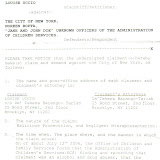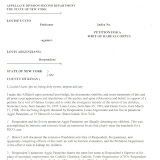Continental Airlines Runway Accident Lawsuit Filed by Passengers
Posted: 14 Jan 2009 01:02 PM CST
Two passengers injured last month when a Continental Airlines flight from Colorado to Houston crashed during takeoff, have filed what is believed to be the first lawsuit involving the runway accident.
Continental Airlines Flight 1404 veered off of the runway and into a ravine at Denver International Airport on December 20, 2008, in what was the only major airplane accident involving a U.S. airline in the past two years.
All 110 passengers and 4 crew members escaped alive from the airplane before it caught fire from a ruptured fuel tank on the right wing, but at least 37 people reported suffering an injury in the crash.
While the National Transportation Safety Board (NTSB) is still investigating what caused the airplane crash, a lawsuit was filed against Continental Airlines and two pilots on January 12, 2009, in Texas state court in Harris County.
The airline accident lawsuit was file by Texas women, Melissa Craft, 25, and Emily Pellegrini, 21, who allege negligence caused the aborted takeoff, possibly due to a combination of pilot error and mechanical fault.
According to the Houston Chronical, Craft suffered a back injury and emotional trauma in the airplane crash, as well as lost property such as jewelry and ski equipment. Pellerini suffered emotional trauma as a result of her inability to open her seatbelt following the crash, and a subsequent slip and fall injury caused by jet fuel that had leaked from a ruptured tank.
Continental Airlines has indicated that the lawsuits are premature, as the reason for the crash is still being investigated.
According to a report published by USA Today on Monday, because there were no fatalities in the Continental airplane runway crash, last year was the second year in a row in which no airline passengers died in an accident.
Only four years since 1958 have not involved any U.S. airline passenger deaths, and 2007 and 2008 were two of them.
FDA Indicates No Apparent Link between Singulair and Suicide
Posted: 14 Jan 2009 12:25 PM CST
In a statement released yesterday, the FDA indicates that while they are continuing to look at data involving potential behavior side effects of Singulair, the agency has not found evidence to suggest that the asthma drug is associated with an increased risk of suicides or suicidal behavior.
In March 2008, the FDA released an early communication to notify the public that they were initiating an investigation into a possible association between Singulair (montelukast) and behavior or mood changes, suicides and suicidal thinking. At that time, they indicated that their preliminary review would take about 9 months before they would draw any conclusions or make recommendations to the public.
After reviewing data submitted by Merck and the manufacturers of other asthma drugs, the FDA indicates that there is no apparent link between Singulair and suicide, although the studies reviewed were not designed to specifically evaluate that risk.
To review the risk of suicide, Merck provide data for 9,929 individuals treated with Singulair and 7,780 individuals who received a placebo. Only one adult treated with Singulair was found to have suicidal ideation or thoughts, and none of the Singulair users had completed suicides, suicide attempts or preparatory acts.
The FDA indicates that they are continuing to review clinical data involving other neuropsychiatric events, such as mood and behavior changes, and no definitive conclusion regarding the association with Singulair has been reached.
According to Merck, data submitted to the drug regulatory agency involving the behavior and mood change analysis, which involved 11,673 individuals treated with Singulair and 8,827 who received a placebo, the incidence of behavior-related events was 2.73% for Singulair and 2.27% for the placebo group.
The warning label for Singulair side effects has been updated several times to reflect potential risks of depression in April 2007, suicidal thinking and behavior in October 2007 and anxiousness in February 2008.
The FDA’s initial announcement in March 2008, about their investigation of the potential suicide risks, came a few months after concerns emerged about suicide side effects of Chantix, a popular anti-smoking drug which has been associated with hundreds of reports of suicides and suicide attempts.
In January 2008, the FDA instituted a new policy which requires drug manufactures to examine potential suicide risks during clinical trials.
Vicks VapoRub Linked to Breathing Problems for Children Under 2
Posted: 14 Jan 2009 10:49 AM CST
The use of Vicks VapoRub in infants and toddlers under 2 years old has been associated with potentially severe respiratory distress, by increasing the production of mucus and reducing the ability to clear mucus in their small airways.
Vicks Vaporub is an over-the-counter medication manufactured by Procter and Gamble, which has been available for over 100 years. It is a topical ointment that is supposed to be rubbed on the chest, throat or sore muscles, to relieve congestion, cough or minor aches and pains.
The Vicks VapoRub warning label indicates that it should not be used by children under 2 years of age, and that it should not be applied in or near the nostrils because it contains camphor which may be toxic if swallowed or absorbed.
A number of parents misuse Vicks VapoRub for young children, and in many cases the product is applied directly in or near the nose, which could cause serious breathing problems according to new research.
A study published in the current issue of Chest, the medical journal of the American College of Chest Physicians, indicates that the use of Vicks VapoRub in children under 2 years old may stimulate excess mucus production, reduce clearing of mucus and cause airway inflammation, potentially leading to respiratory distress because of the small size of young children’s airways.
Researchers from the Wake Forest University School of Medicine point out that Vicks VapoRub does not actually remove congestion, but only makes the brain think the airways are open by use of menthol, camphor and eucalyptus oil.
The study was started after an 18-month old girl was rushed to the emergency room with severe breathing problems which did not respond to a rescue inhaler or steroids. It was summertime and the child had a virus induced common cold. Her grandparents had placed a dab of Vicks VapoRub under her nose for breathing relief.
The researchers used windpipes separated from dead ferrets to study the effects of Vicks VapoRub on respiratory distress, because ferrets have airways similar to humans. Vicks increased mucus production by 59 percent and reduced the ability to clear mucus by 36 percent. In healthy ferrets, Vicks VapoRub increased mucus secretion by 14 percent and by 8 percent in ferrets with induced airway inflammation. These results were not statistically significant. The results of a Procter & Gamble funded study on the efficacy of Vicks as a treatment for the common cold and bronchitis are expected in two years.
Researchers stress that it is important for consumers to only use Vicks VapoRub as directed on the label for those 2 years and over, and never in or around the nostrils for adults or children.
In October 2008, the manufacturers of over-the-counter children’s cough and cold drugs indicated that none of the medications should be used in children under four. Consumer advocacy groups have called for a ban on children under 6, which is the restriction placed on children’s cough and cold medicines in Canada.
Stork Craft Baby Crib Recall: Over 500,000 Cribs
Posted: 14 Jan 2009 10:00 AM CST
Another major baby crib recall has been issued, this time involving about 535,000 Stork Craft cribs sold in the United States and another 494,000 in Canada. The U.S. Consumer Product Safety Commission (CPSC) indicates that defective metal support brackets on the baby cribs could break, causing the mattress to collapse and create a risk of entrapment or suffocation for infants.
The Stork Craft baby crib recall applies to all cribs manufactured and sold since May 2000, regardless of the model, style or finish. The date the crib was recalled and the manufacturer’s name, Stork Craft Manufacturing, Inc., of British Columbia, Canada, are located on the assembly instruction sheet attached to the mattress support board.
The cribs were sold throughout the United States at Kmart, Wal-Mart and JC Penney stores, as well as online at Babiesrus.com, Walmart.com, Amazon.com and Costco.com. The prices ranged from between $100 to $400.
The U.S. CPSC indicates that at least 10 reports have been received where one or more of the metal mattress support brackets broke, including several reports where the mattress collapsed, creating a dangerous gap between the mattress and the crib rails. One report involved a toddler who suffered a head injury, including bruises to his forehead, and another child became entrapped in the gap, but suffered no injury.
Owners of any Stork Craft cribs have been urged to stop using the crib and to contact Stork Crafft at (866) 361-3321 to receive a free replacement kit with new mattress support brackets.
Since the U.S. CPSC instituted new procedures for handling safety complaints in 2007, millions of baby cribs have been recalled in the United States.
In October 2008, nearly 1,585,000 cribs were impacted by a Delta crib recall, after several babies died due to problems with the safety and spring pegs, which could allow the drop side of the crib to disengage, creating a dangerous gap between the mattress and side of the crib.
Earlier this month, a Jardine Babies R Us crib recall, which was originally issued in June 2008 , was expanded to include over 375,000 baby cribs that were found to contain defective slats that could break, creating a dangerous gap in which the baby could get stuck, fall out of the crib or strangle themselves.























No comments:
Post a Comment